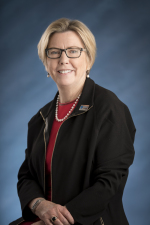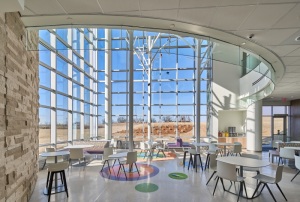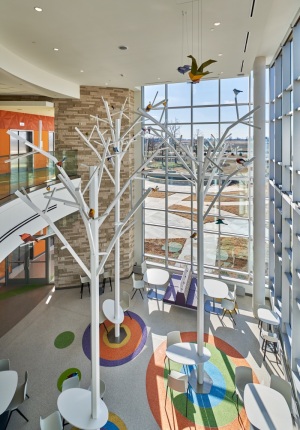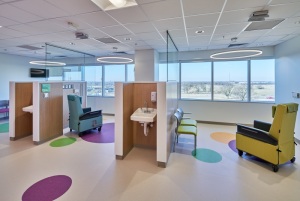Hospital Spotlight Q&A with Trisha Montague, chief administrator for Arkansas Children's Northwest
October 05, 2018
by Sean Ruck, Contributing Editor
Arkansas Children’s Northwest is the nation’s newest stand-alone children’s hospital. Its campus opened in early spring, hosting 24 inpatient beds and the region’s only pediatric emergency room. HCB News spoke with the hospital’s chief administrator, Trisha Montague to learn more about her background and about the new hospital.
HCB News: What inspired you to follow a career in healthcare?
Trisha Montague: Honestly, I am one of those people, even as a small child, I was very interested in nursing as a career. I just always loved being with people and I was the little girl going around finding animals to take care of. As I got through high school and thinking about college, nursing was all I was interested in. My first rotation in pediatrics – that was it for me – I knew it was my calling. I’ve been a pediatric nurse ever since.
HCB News: What attracted you to Arkansas Children's Northwest?
TM: I actually worked at Arkansas Children’s Hospital in Little Rock a number of years ago. So I was very familiar with the healthcare system in Little Rock and their reputation, and the level of care they provided. When the opportunity came up to build a greenfield small children’s hospital and to create something really transformative for a community, it was certainly something I was going to consider. To add to that, there’s the president and CEO of Arkansas Children’s hospital, Marcy Doderer. I worked with her in San Antonio at a children’s hospital there previously, so I knew her very well and certainly considered her a person I’d love to work with again. It was really a combination primarily of the uniqueness of the opportunity and the chance to make a difference in a community that didn’t have a children’s hospital nearby, and knowing I was going to be working with a visionary leader.
HCB News: What kind of population does Arkansas Children's serve?
TM: Northwest Arkansas is an interesting community. The world’s largest company is headquartered here and there are a couple of Forbes 500 companies too, so there’s wealth and growth and high-level executives. There are also parts of Northwest Arkansas that have some of the most underserved communities in the state. So it’s really a combination. When we look at who our patients and payors are, we’re looking at probably about 63 percent of our population as Medicaid, then private pay and about 4 percent self-pay.
HCB News: What challenges does the hospital face that are specific to treating children?
TM: Pediatric healthcare is unique, with its own standards of care and body of evidence of what’s best for children that might be differentiated from adults. So that’s one challenge right out of the gate.
There are about 200 children hospitals in the country, so legislation, recognition, research, funding, all of those things – children’s hospitals are not always at the top-of-mind. Children don’t vote, so when you’re working with the politicians you have a different level of conversation as far as advocacy goes. It makes it uniquely challenging to have a level playing field.
The other thing about children’s hospitals is that our expertise is from the smallest of neonates up to someone like a 20-year-old linebacker for the Razorbacks. So you have to have the knowledge and ability to deal with that spectrum of people and to also have the equipment and supplies. You don’t have one set of adult oxygen masks, you have five sets of different sizes. That just repeats throughout all your medical supplies and equipment. That’s one of the reasons children’s hospitals are more challenging from a financial standpoint, because you need to have everything available for any size patient that may come through the door.
Another thing is that your patient isn’t just the child, but the family as well. It’s about taking care of the family as a whole.
HCB News: What kind of accommodations or children-specific attributes does your hospital have?
TM: That experience really starts as soon as they walk through the door. That was a very intentional part of our design process throughout the hospital. We wanted there to be an experience from the moment they walked through the door where they say, “It’s a warm, inviting, interesting place that engages me and doesn’t frighten me at all.” I think it’s really important for kids and parents to be able to enter and have that experience right from the beginning. We did that here with a design concept we call “discovery and delight” that has different little things like a little bird or squirrel that children can find throughout the hospital. Another example would be our MRI scanner. We installed this newer kind of pediatric scanner in a room that’s set up with a whole lighting system and video system. Before the child goes into the MRI, they sit with the tech to pick out the colors and videos. It’s a cool digital process for choosing things. That was something we invested in and it turned out to be super popular for all ages. We also have a child-life specialist program which is a standard of care. It’s really an important part of effectively taking care of families.
HCB News: Do you believe the appropriate levels of investment are being made in children’s healthcare today?
TM: I want to be clear that this is speaking from my perspective. I think what’s challenging about pediatric and reimbursement these days is that Medicaid is federally funded, but state-regulated. So one state may be reimbursing hospitals in a reasonable manner for their Medicaid populations and another state may be really difficult. That really varies. In the last few years, all the workarounds and how things are reimbursed make it challenging. I think the big challenge for children’s healthcare, as I mentioned earlier, is getting the attention of legislators. And the way Medicaid is regulated right now is a little challenging.
HCB News: With hospitals being a place for ill individuals and children undergoing treatment sometimes having compromised immune systems, is there a concern with the growth of non-vaccinated children arriving for treatment?
TM: As a pediatric healthcare provider, I would say we absolutely have a concern about that and that is a little bit of an issue specifically in this community. The concern is partly ensuring that we’re keeping everyone safe within our hospital. That’s why we have a lot of different screenings in place to make sure we understand who’s coming in through the door. Moreover, we know from the science that vaccinations can prevent what can be deadly diseases. So it’s not just about preventing the spread of disease within a community, but also about the individual child avoiding a disease that could cause long-term complications or even death. For instance, there was an outbreak of mumps in this community a couple of years ago.
HCB News: What are your predictions on how child-focused healthcare should change and how it might change over the next five to 10 years?
TM: I think in pediatric healthcare we have the advantage of a relatively small community, compared to the rest of healthcare. It allows us to come together and learn best practices from each other, do focused research on children, and gain knowledge about patient safety and outcomes in a much more nimble way. There’s an international association called the Children’s Hospital Association. In the past 10 years or so it’s become much more comprehensive, and this group has developed what they call “solutions for patient safety.” They’re bringing experts from children’s hospitals around the world and pooling knowledge and resources around understanding what the safety risks are for children in hospitals and clinics, what the pediatric healthcare outcomes are that we believe we want to make an impact on but haven’t yet, and working toward comprehensive solutions. I see pediatric healthcare really setting a high bar in relation to the rest of healthcare as to how we can come together and benefit the patients we serve.
Arkansas Children’s Northwest
Location: Springdale, Arkansas
Year founded: Opened Feb. 27, 2018
Number of beds: 24 inpatient beds and 30 clinic rooms
Number of employees: 350+
Senior Vice President and Chief Administrator: Trisha Montague, MSN, RN, NEA-BC
Noteworthy distinctions:
As the region’s only comprehensive pediatric health center, Arkansas Children’s Northwest offers families:
• 233,613 square feet of wellness space designed to maximize children’s discovery & delight
• A state-of-the-art pediatric surgery center with 5 operating rooms
• A full range of ancillary and diagnostic services, child-life, social work and pastoral care programs
• Outdoor gardens, nature trails and interactive features designed specifically for children
• A helipad and refueling station supporting Angel One, one of the nation’s leading pediatric intensive care transport services
Specialties:
• Region’s only pediatric emergency room
• Pediatric cardiology
• Pediatric neurology
• Pediatric hematology/oncology
• Pediatric pulmonology
Recent developments:
Arkansas Children’s Northwest offers families the first and only children’s hospital and pediatric emergency department in the region. The health system moved existing outpatient clinics from Lowell, Arkansas to the new facility in January.
In late February, Arkansas Children’s Northwest opened to inpatient care, offering 24 beds. ACNW was built on 37 acres in Springdale donated by Robin and Gary George, Cathy and David Evans and their families, a $7.5 million investment in the region’s children. The new campus joins a flagship hospital in Little Rock, a statewide transport system dedicated to delivering children in critical condition to lifesaving care, and a range of outreach programs that includes telemedicine, mobile health and school-based health solutions.
HCB News: What inspired you to follow a career in healthcare?
Trisha Montague: Honestly, I am one of those people, even as a small child, I was very interested in nursing as a career. I just always loved being with people and I was the little girl going around finding animals to take care of. As I got through high school and thinking about college, nursing was all I was interested in. My first rotation in pediatrics – that was it for me – I knew it was my calling. I’ve been a pediatric nurse ever since.
HCB News: What attracted you to Arkansas Children's Northwest?
TM: I actually worked at Arkansas Children’s Hospital in Little Rock a number of years ago. So I was very familiar with the healthcare system in Little Rock and their reputation, and the level of care they provided. When the opportunity came up to build a greenfield small children’s hospital and to create something really transformative for a community, it was certainly something I was going to consider. To add to that, there’s the president and CEO of Arkansas Children’s hospital, Marcy Doderer. I worked with her in San Antonio at a children’s hospital there previously, so I knew her very well and certainly considered her a person I’d love to work with again. It was really a combination primarily of the uniqueness of the opportunity and the chance to make a difference in a community that didn’t have a children’s hospital nearby, and knowing I was going to be working with a visionary leader.
HCB News: What kind of population does Arkansas Children's serve?
TM: Northwest Arkansas is an interesting community. The world’s largest company is headquartered here and there are a couple of Forbes 500 companies too, so there’s wealth and growth and high-level executives. There are also parts of Northwest Arkansas that have some of the most underserved communities in the state. So it’s really a combination. When we look at who our patients and payors are, we’re looking at probably about 63 percent of our population as Medicaid, then private pay and about 4 percent self-pay.
HCB News: What challenges does the hospital face that are specific to treating children?
TM: Pediatric healthcare is unique, with its own standards of care and body of evidence of what’s best for children that might be differentiated from adults. So that’s one challenge right out of the gate.
There are about 200 children hospitals in the country, so legislation, recognition, research, funding, all of those things – children’s hospitals are not always at the top-of-mind. Children don’t vote, so when you’re working with the politicians you have a different level of conversation as far as advocacy goes. It makes it uniquely challenging to have a level playing field.
The other thing about children’s hospitals is that our expertise is from the smallest of neonates up to someone like a 20-year-old linebacker for the Razorbacks. So you have to have the knowledge and ability to deal with that spectrum of people and to also have the equipment and supplies. You don’t have one set of adult oxygen masks, you have five sets of different sizes. That just repeats throughout all your medical supplies and equipment. That’s one of the reasons children’s hospitals are more challenging from a financial standpoint, because you need to have everything available for any size patient that may come through the door.
Another thing is that your patient isn’t just the child, but the family as well. It’s about taking care of the family as a whole.
HCB News: What kind of accommodations or children-specific attributes does your hospital have?
TM: That experience really starts as soon as they walk through the door. That was a very intentional part of our design process throughout the hospital. We wanted there to be an experience from the moment they walked through the door where they say, “It’s a warm, inviting, interesting place that engages me and doesn’t frighten me at all.” I think it’s really important for kids and parents to be able to enter and have that experience right from the beginning. We did that here with a design concept we call “discovery and delight” that has different little things like a little bird or squirrel that children can find throughout the hospital. Another example would be our MRI scanner. We installed this newer kind of pediatric scanner in a room that’s set up with a whole lighting system and video system. Before the child goes into the MRI, they sit with the tech to pick out the colors and videos. It’s a cool digital process for choosing things. That was something we invested in and it turned out to be super popular for all ages. We also have a child-life specialist program which is a standard of care. It’s really an important part of effectively taking care of families.
HCB News: Do you believe the appropriate levels of investment are being made in children’s healthcare today?
TM: I want to be clear that this is speaking from my perspective. I think what’s challenging about pediatric and reimbursement these days is that Medicaid is federally funded, but state-regulated. So one state may be reimbursing hospitals in a reasonable manner for their Medicaid populations and another state may be really difficult. That really varies. In the last few years, all the workarounds and how things are reimbursed make it challenging. I think the big challenge for children’s healthcare, as I mentioned earlier, is getting the attention of legislators. And the way Medicaid is regulated right now is a little challenging.
HCB News: With hospitals being a place for ill individuals and children undergoing treatment sometimes having compromised immune systems, is there a concern with the growth of non-vaccinated children arriving for treatment?
TM: As a pediatric healthcare provider, I would say we absolutely have a concern about that and that is a little bit of an issue specifically in this community. The concern is partly ensuring that we’re keeping everyone safe within our hospital. That’s why we have a lot of different screenings in place to make sure we understand who’s coming in through the door. Moreover, we know from the science that vaccinations can prevent what can be deadly diseases. So it’s not just about preventing the spread of disease within a community, but also about the individual child avoiding a disease that could cause long-term complications or even death. For instance, there was an outbreak of mumps in this community a couple of years ago.
HCB News: What are your predictions on how child-focused healthcare should change and how it might change over the next five to 10 years?
TM: I think in pediatric healthcare we have the advantage of a relatively small community, compared to the rest of healthcare. It allows us to come together and learn best practices from each other, do focused research on children, and gain knowledge about patient safety and outcomes in a much more nimble way. There’s an international association called the Children’s Hospital Association. In the past 10 years or so it’s become much more comprehensive, and this group has developed what they call “solutions for patient safety.” They’re bringing experts from children’s hospitals around the world and pooling knowledge and resources around understanding what the safety risks are for children in hospitals and clinics, what the pediatric healthcare outcomes are that we believe we want to make an impact on but haven’t yet, and working toward comprehensive solutions. I see pediatric healthcare really setting a high bar in relation to the rest of healthcare as to how we can come together and benefit the patients we serve.
Arkansas Children’s Northwest
The nation’s newest children’s hospital is built on 37 acres of land donated by Robin and Gary George, Cathy
and David Evans and their families, a $7.5 million investment in the region’s children.
and David Evans and their families, a $7.5 million investment in the region’s children.
Natural light and an open, airy design makes Arkansas
Children’s Northwest an inviting place where children
are less intimidated by the sometimes frightening
medical procedures ahead of them.
Children’s Northwest an inviting place where children
are less intimidated by the sometimes frightening
medical procedures ahead of them.
Year founded: Opened Feb. 27, 2018
Number of beds: 24 inpatient beds and 30 clinic rooms
Number of employees: 350+
Senior Vice President and Chief Administrator: Trisha Montague, MSN, RN, NEA-BC
Sculptures across the new hospital were strategically
created to inspire “discovery and delight”
for visitors of all ages. Photo credit Ken West.
created to inspire “discovery and delight”
for visitors of all ages. Photo credit Ken West.
As the region’s only comprehensive pediatric health center, Arkansas Children’s Northwest offers families:
• 233,613 square feet of wellness space designed to maximize children’s discovery & delight
• A state-of-the-art pediatric surgery center with 5 operating rooms
• A full range of ancillary and diagnostic services, child-life, social work and pastoral care programs
• Outdoor gardens, nature trails and interactive features designed specifically for children
• A helipad and refueling station supporting Angel One, one of the nation’s leading pediatric intensive care transport services
Specialties:
• Region’s only pediatric emergency room
• Pediatric cardiology
• Pediatric neurology
• Pediatric hematology/oncology
• Pediatric pulmonology
Recent developments:
Arkansas Children’s Northwest offers families the first and only children’s hospital and pediatric emergency department in the region. The health system moved existing outpatient clinics from Lowell, Arkansas to the new facility in January.
Arkansas Children’s Northwest offers families lifesaving
diagnostic services in its imaging center, complete with
child-savvy designs and lighting that distracts young patients.
diagnostic services in its imaging center, complete with
child-savvy designs and lighting that distracts young patients.




